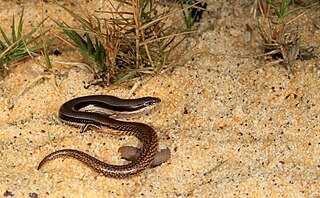
Gehyra is a genus of geckos in the family Gekkonidae. They are known as web-toed geckos or dtellas, and most species within the genus bear close resemblance to geckos from the genus Hemidactylus.

Heteronotia is a genus of geckos, lizards in the family Gekkonidae. The genus is endemic to Australia. Species in the genus Heteronotia are commonly known as prickly geckos.

Diplodactylus is a genus of geckos of the family Diplodactylidae from Australia. They are sometimes called stone geckos or fat-tailed geckos. Member species are morphologically similar but genetically distinct.

The beaded gecko is a gecko endemic to Australia.

Oedura is a genus of medium to large geckos, lizards in the family Diplodactylidae. The genus is endemic to Australia. Species in the genus are referred to by the common name velvet geckos.

Diporiphora is a genus of lizards in the family Agamidae. Most species in the genus are endemic to Australia, but two are also found in New Guinea.

Eremiascincus is a genus of skinks, lizards in the family Scincidae. The genus is endemic to Australia, Indonesia, and East Timor.

Lerista is a diverse genus of skinks endemic to Australia, commonly known as sliders. The genus is especially notable for the variation in the amount of limb reduction. The variation ranges from short-bodied forms with large legs bearing five toes, to elongate forms completely lacking legs. The body length of the lizards is 33–103 millimetres (1.3–4.1 in). Their locomotion is linked to their body shape. The shorter skinks with prominent limbs travel on the surface; the longer skinks with reduced legs tend to burrow more. A phylogenetic tree of Lerista, derived from DNA analysis, reveals that limb loss has happened multiple times within this group. Limb loss has occurred relatively recently, in the past 3.6 million years or so.

Crenadactylus, the clawless geckos, are named for their distinguishing feature, the absence of terminal claws on the digits. They are the only Australian members of Gekkonidae to lack claws, the endemic genus is also the smallest in size.

The Diplodactylidae are a family in the suborder Gekkota (geckos), with over 150 species in 25 genera. These geckos occur in Australia, New Zealand, and New Caledonia. Diplodactylids are the most ecologically diverse and widespread family of geckos in both Australia and New Caledonia, and are the only family of geckos found in New Zealand. Three diplodactylid genera have recently been split into multiple new genera

Lucasium steindachneri, commonly called the box-patterned gecko or Steindachner's gecko, is a species of nocturnal, medium-sized lizard in the family Diplodactylidae. The species has a pale strip with three patches of brown along its back. This gecko is terrestrial and only found in arid and semi-arid areas of continental Australia.
Lucasium byrnei, commonly known as the gibber gecko or Byrne's gecko, is a species of small, nocturnal gecko, a lizard in the family Diplodactylidae. The species is endemic to Australia.

Lucasium stenodactylum, also known as the crowned gecko or pale-snouted ground gecko, is a species of gecko from Australia.
Diplodactylus savagei, known commonly as the yellow-spotted Pilbara gecko, is a species of lizard in the family Diplodactylidae. The species is endemic to Australia.

Main's ground gecko is a species of gecko, a lizard in the family Diplodactylidae. The species is endemic to Australia.
The Pilbara ground gecko also known commonly as Wombey's gecko, is a species of lizard in the family Diplodactylidae. The species is endemic to Australia.
Oedura argentea is a species of velvet gecko that has been recently described from the sandstone ranges of central-north Queensland, Australia.

Pygopodoidea is a gecko superfamily and the only taxon in the gekkotan subclade Pygopodomorpha. The clade includes three Australasian families: Diplodactylidae, Carphodactylidae, and Pygopodidae. Traditional gekkotan systematics had considered Diplodactylidae and Carphodactylidae as subfamilies of the family Gekkonidae, but recent molecular work have placed Pygopodidae within Gekkonidae making it paraphyletic. These analyses have shown support of Pygopodidae and Carphodactylidae being sister taxa, with Diplodactylidae occupying a basal position in Pygopodoidea.
Crenadactylus horni, the Central Uplands clawless gecko, is a species of gecko endemic to the central desert region of Australia.
Crenadactylus pilbarensis is a species of gecko found in the Pilbara region of Western Australia. They resemble other species of the genus Crenadactylus, tiny clawless Australian geckos found across a large area of the continent, but has persisted as an ancient lineage in a region of the northwest.












